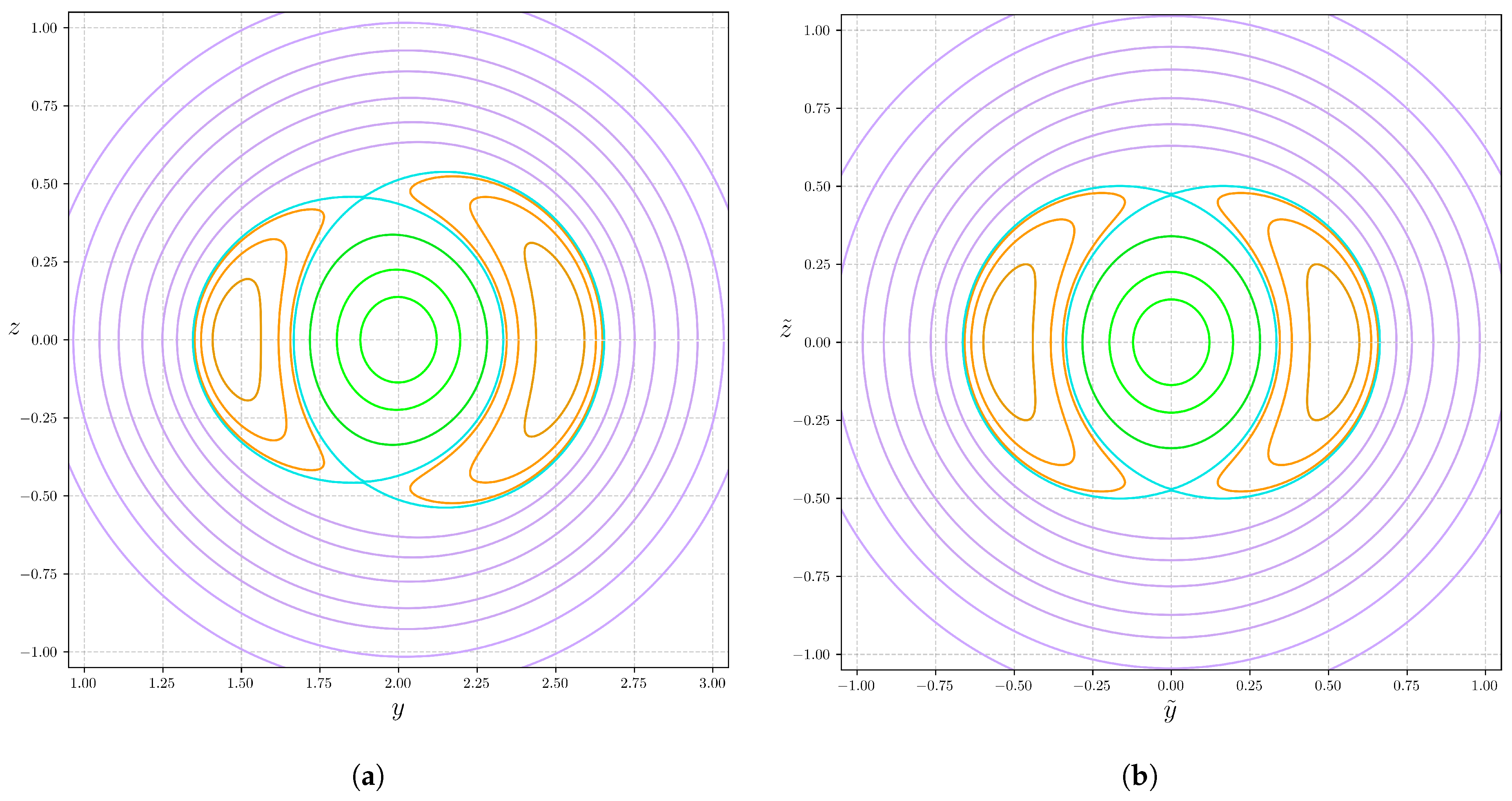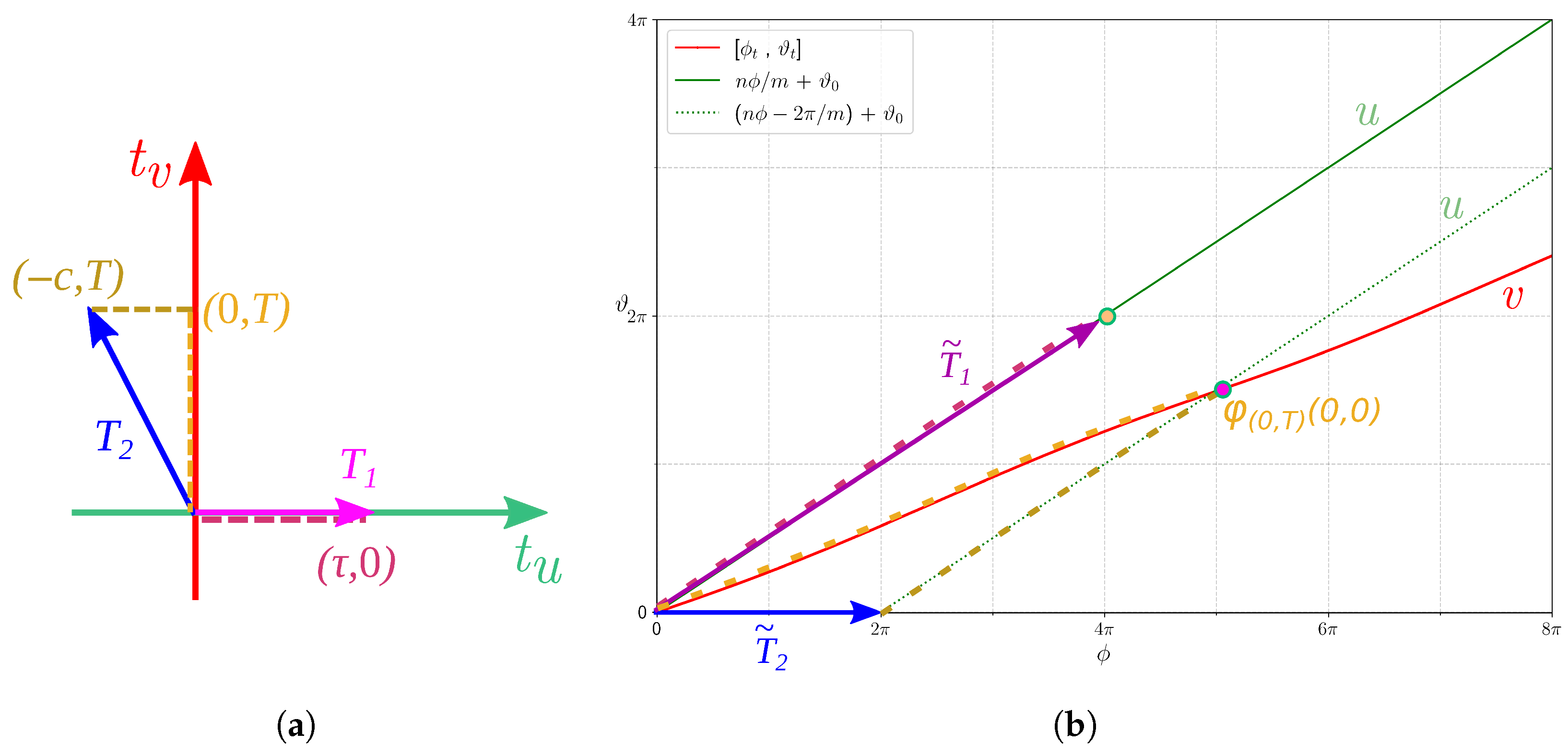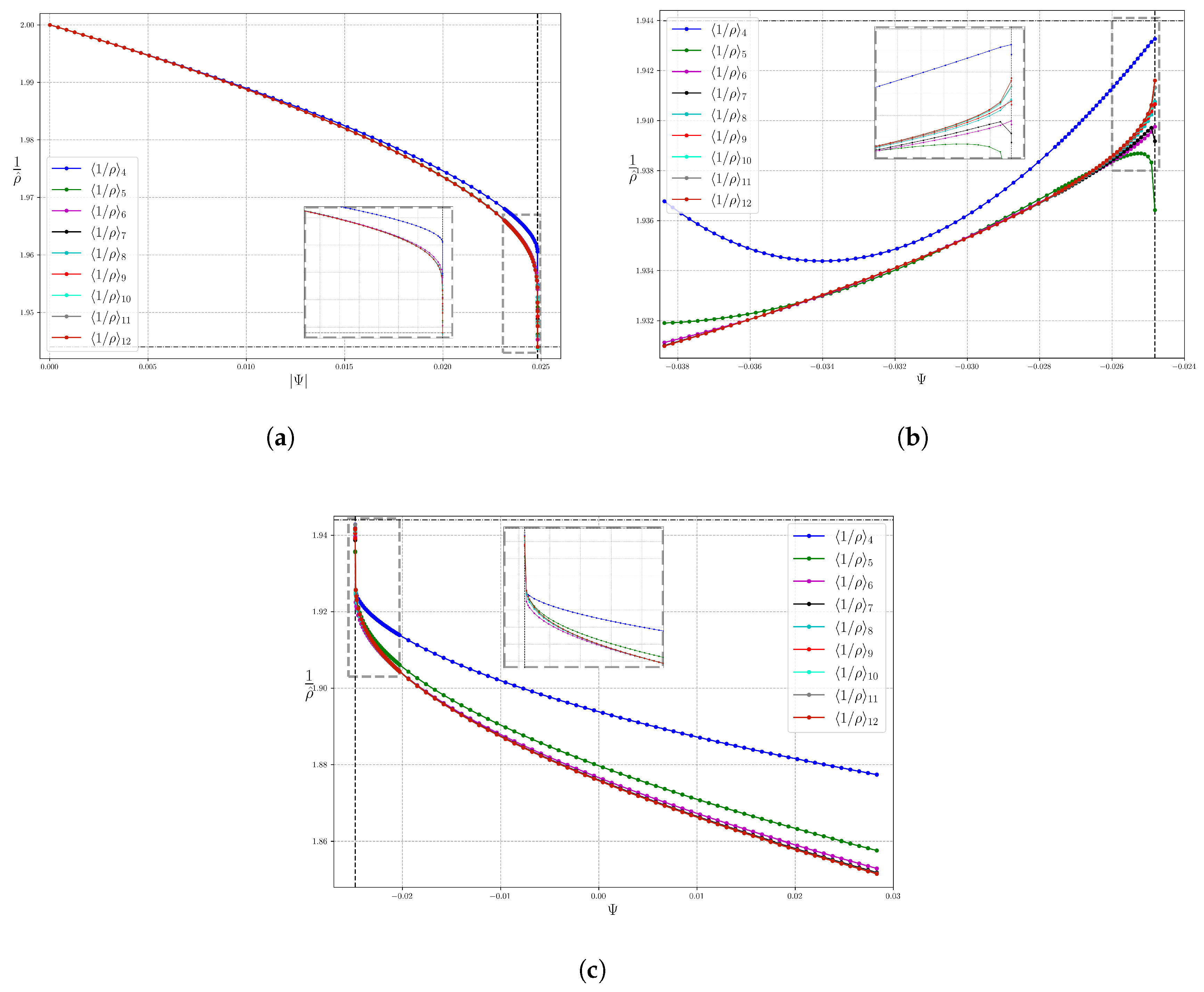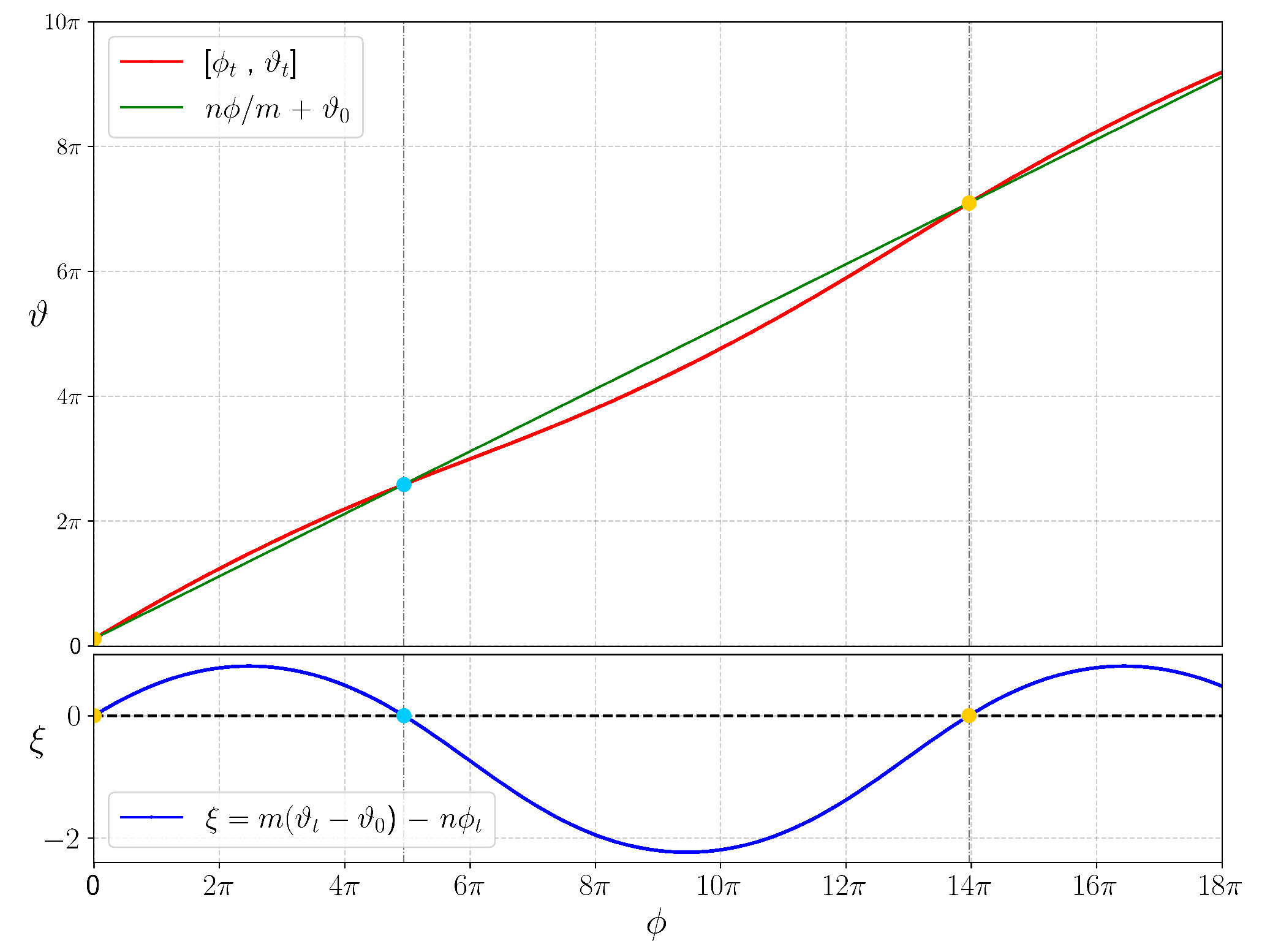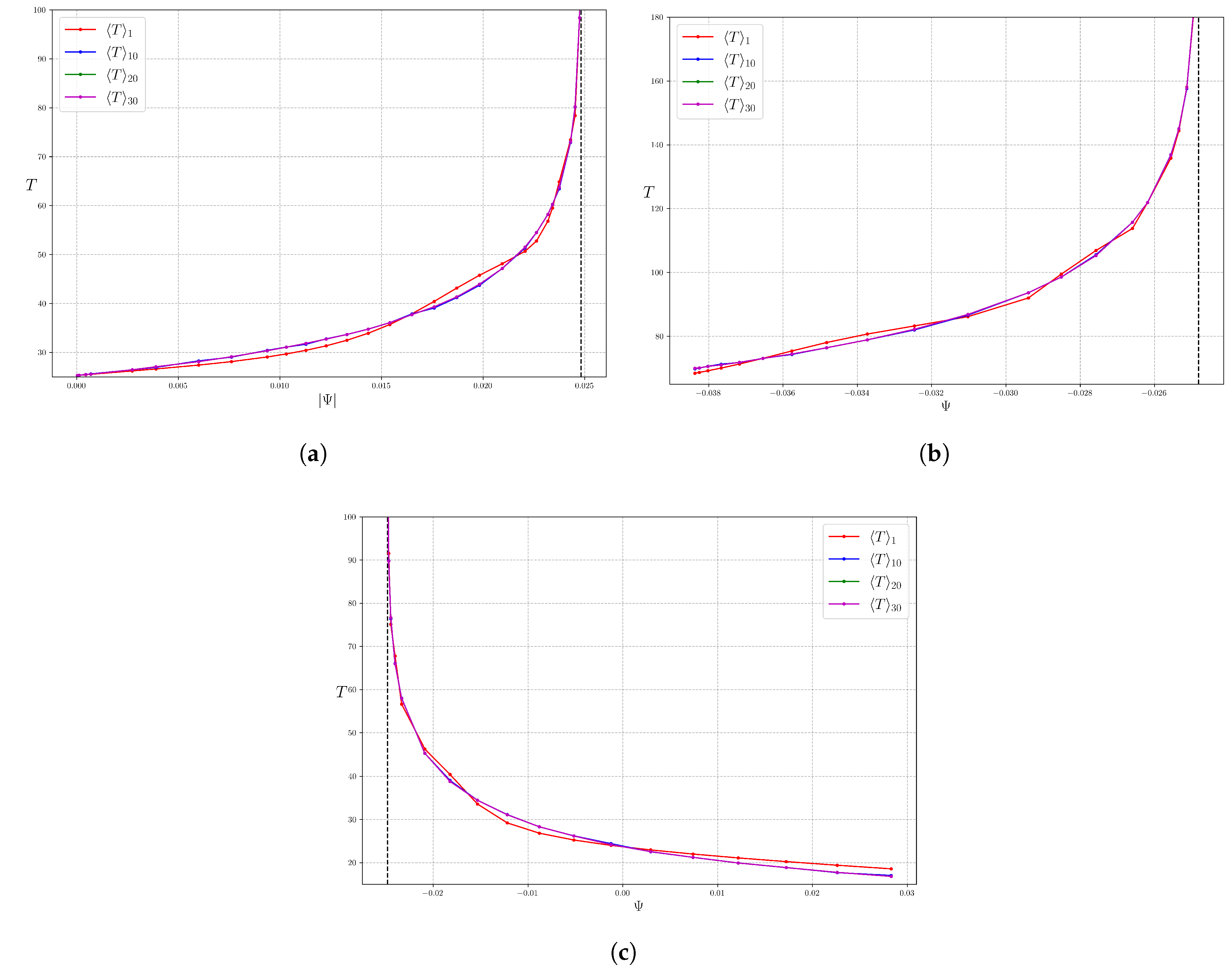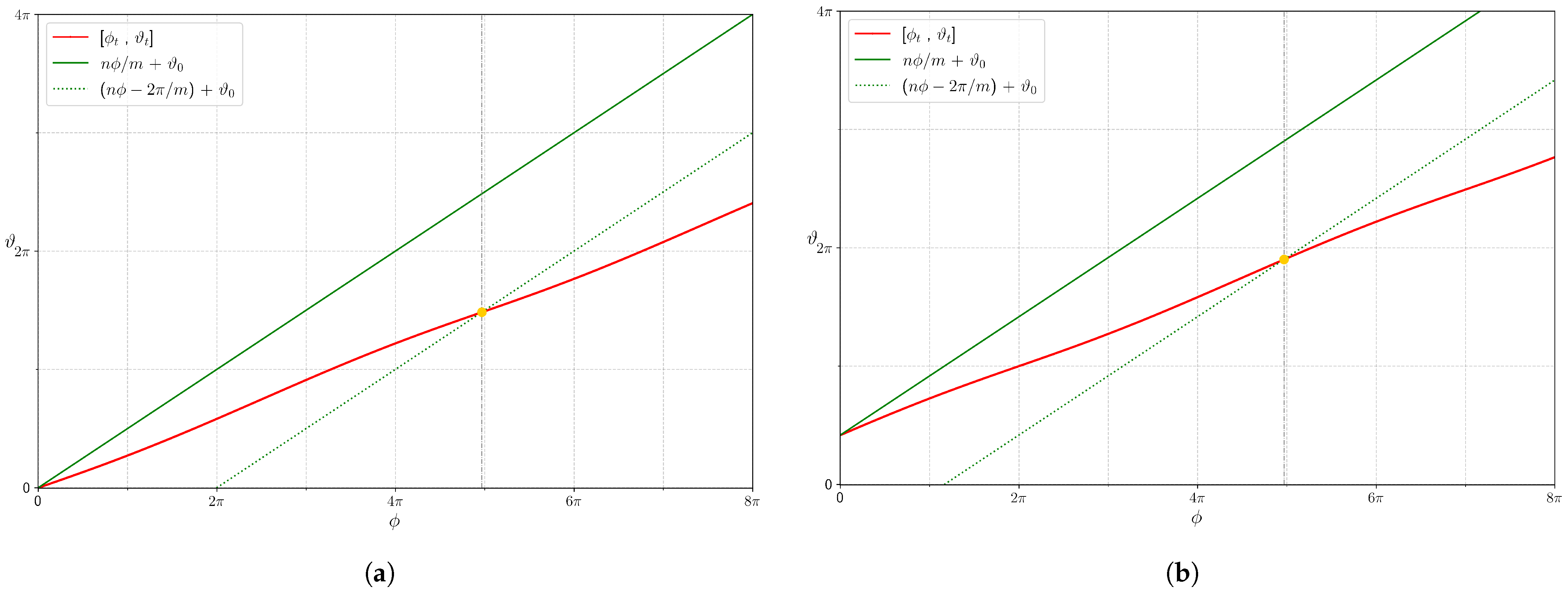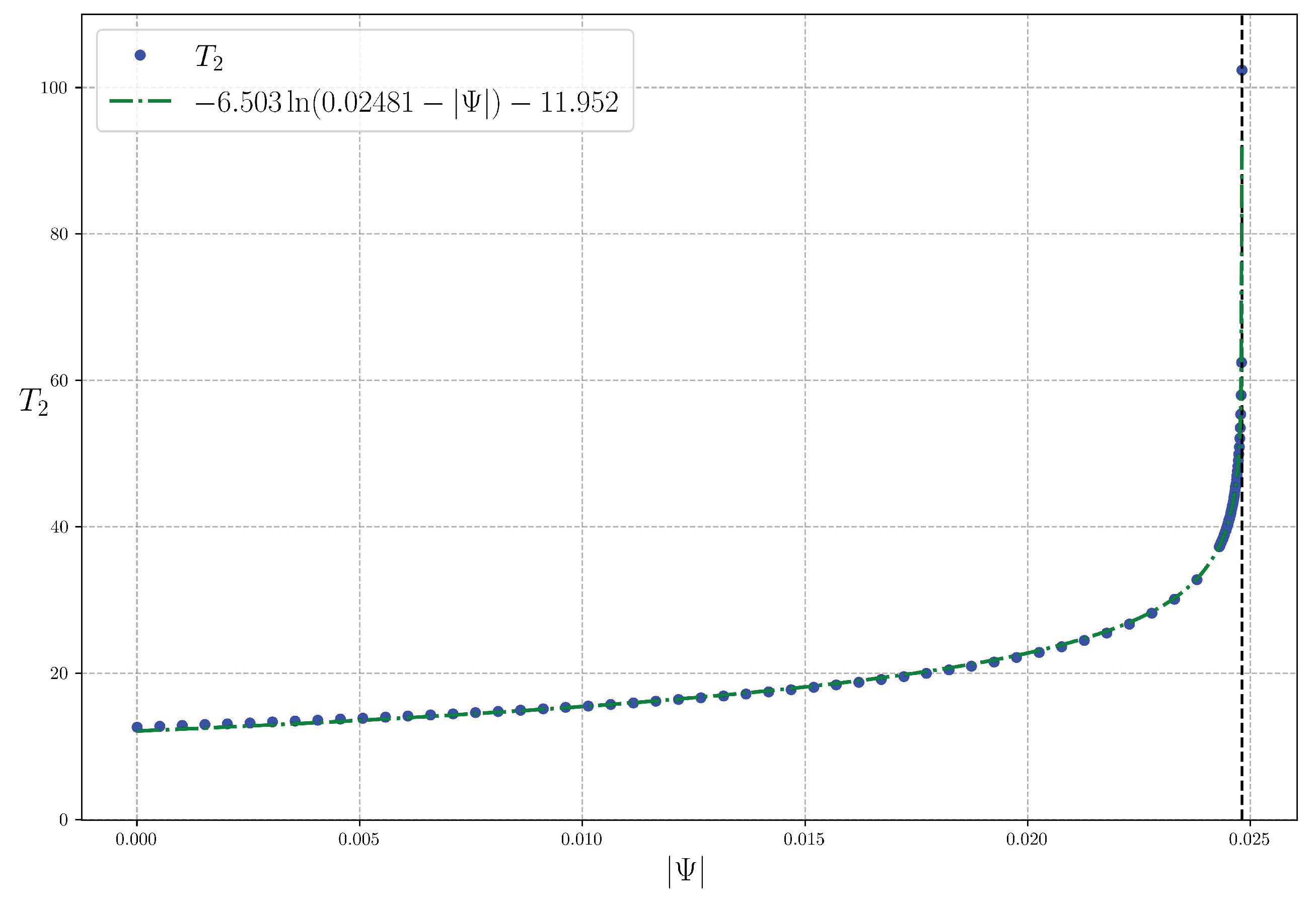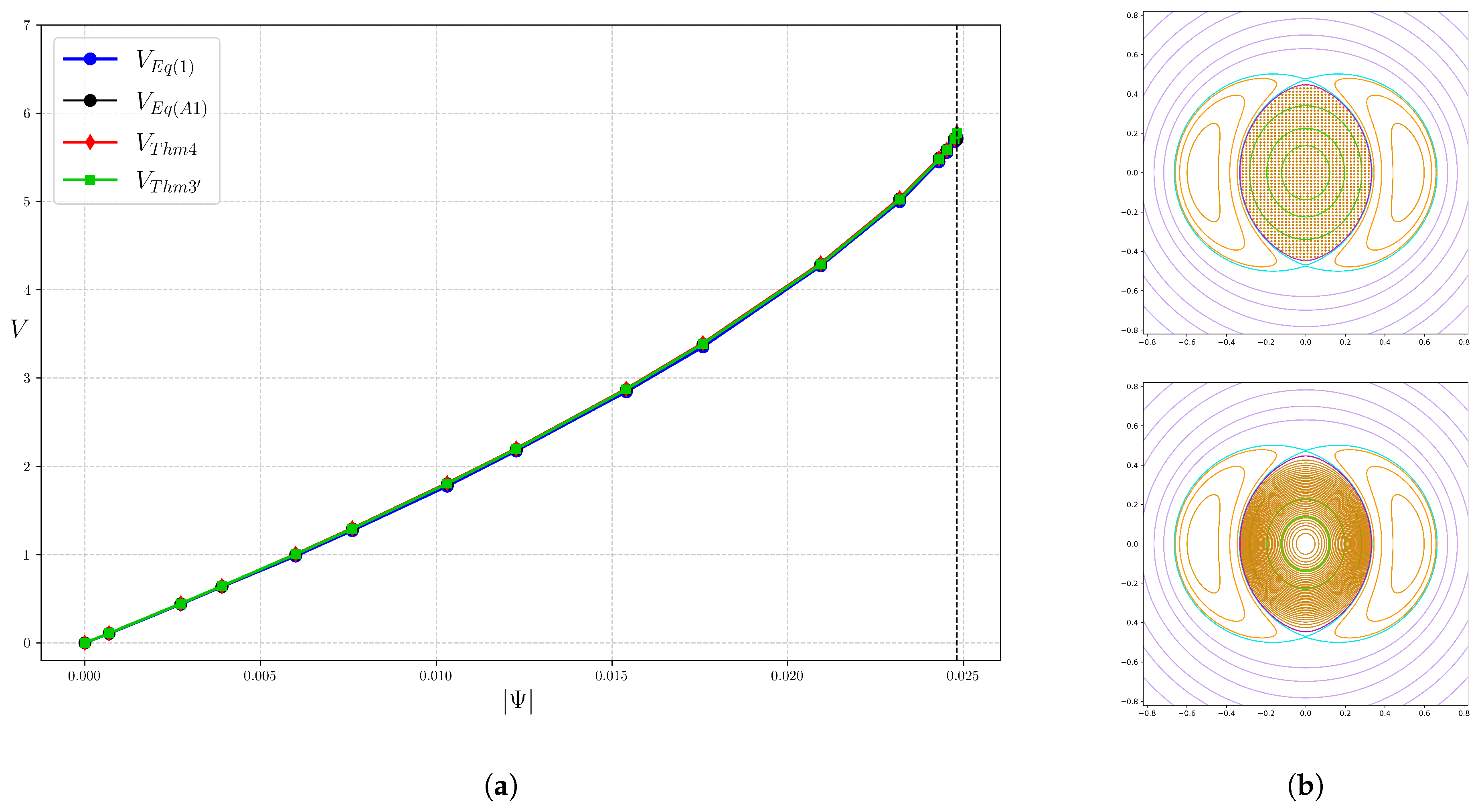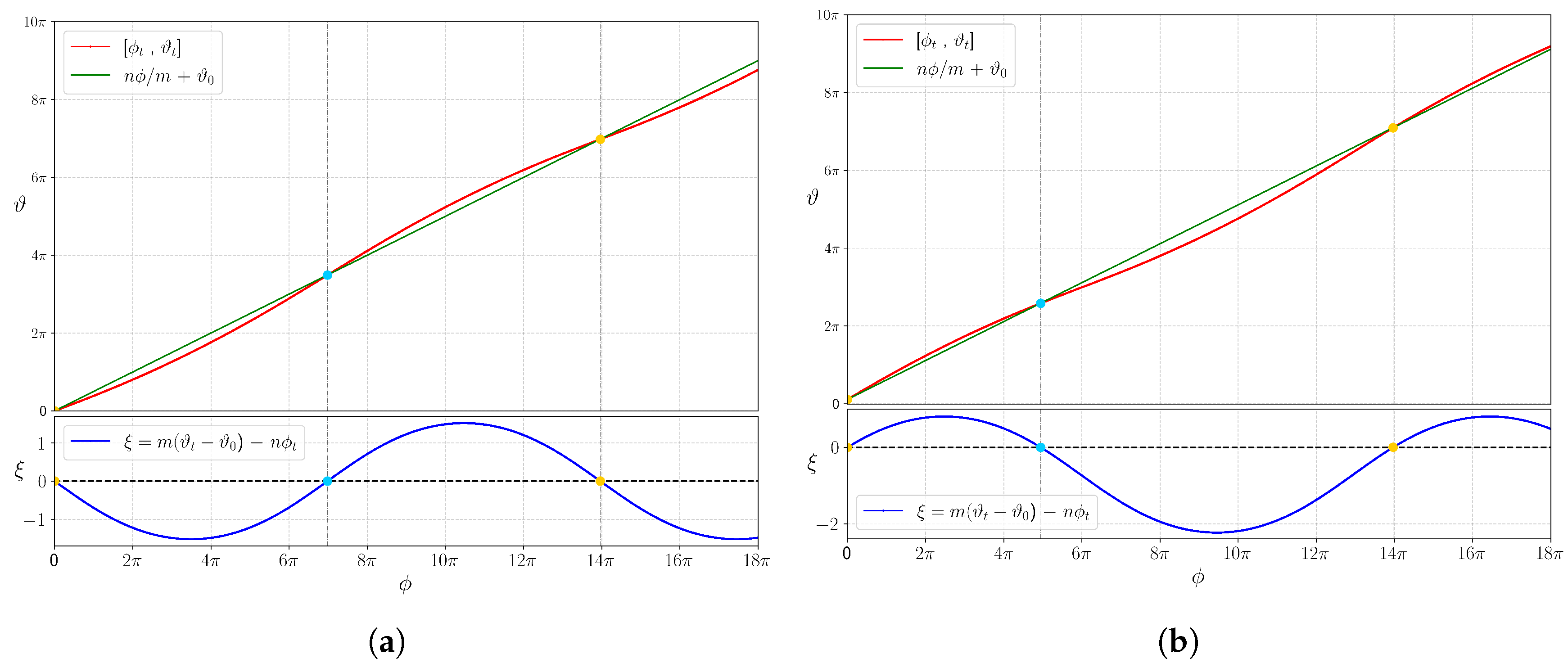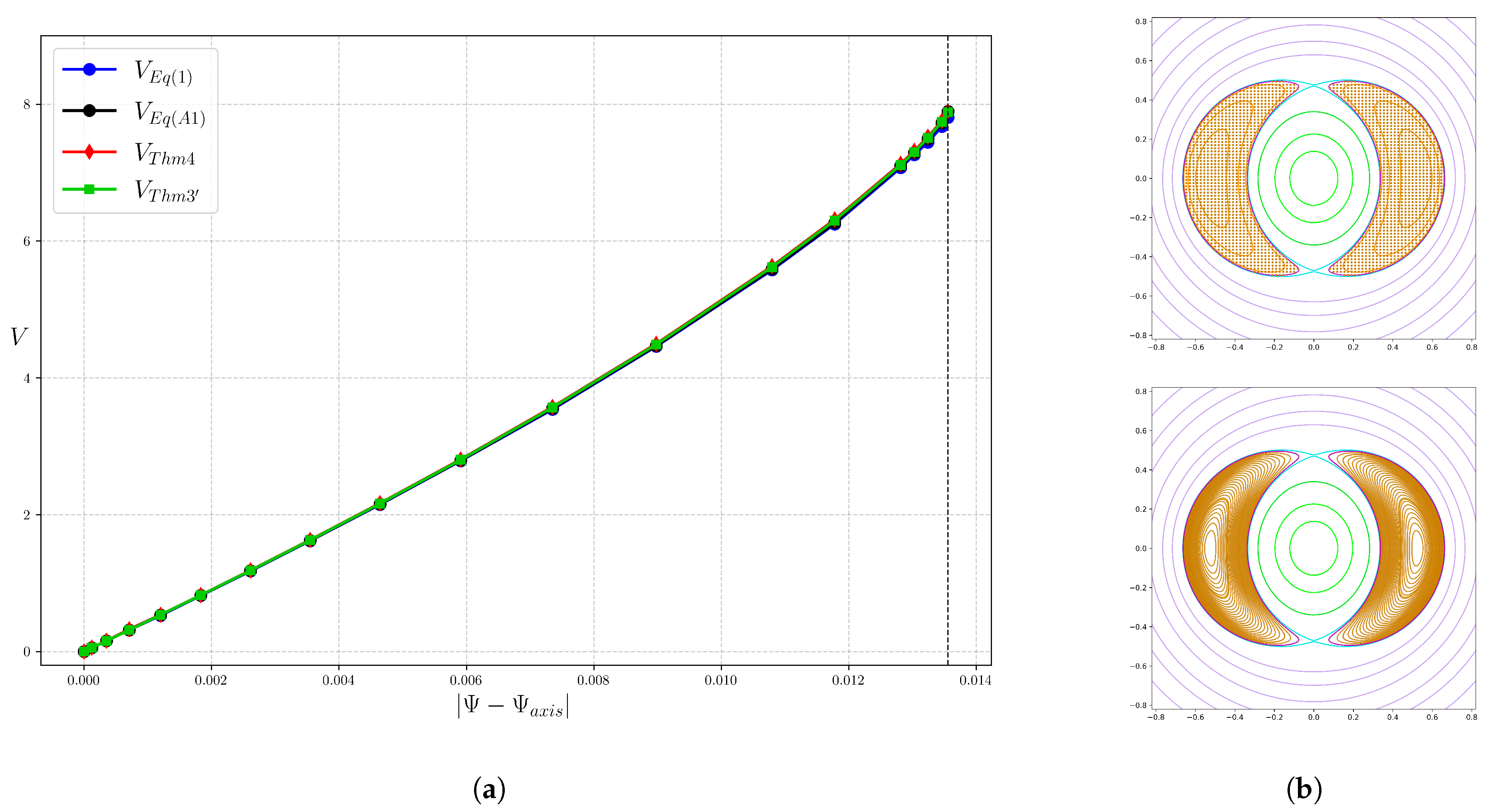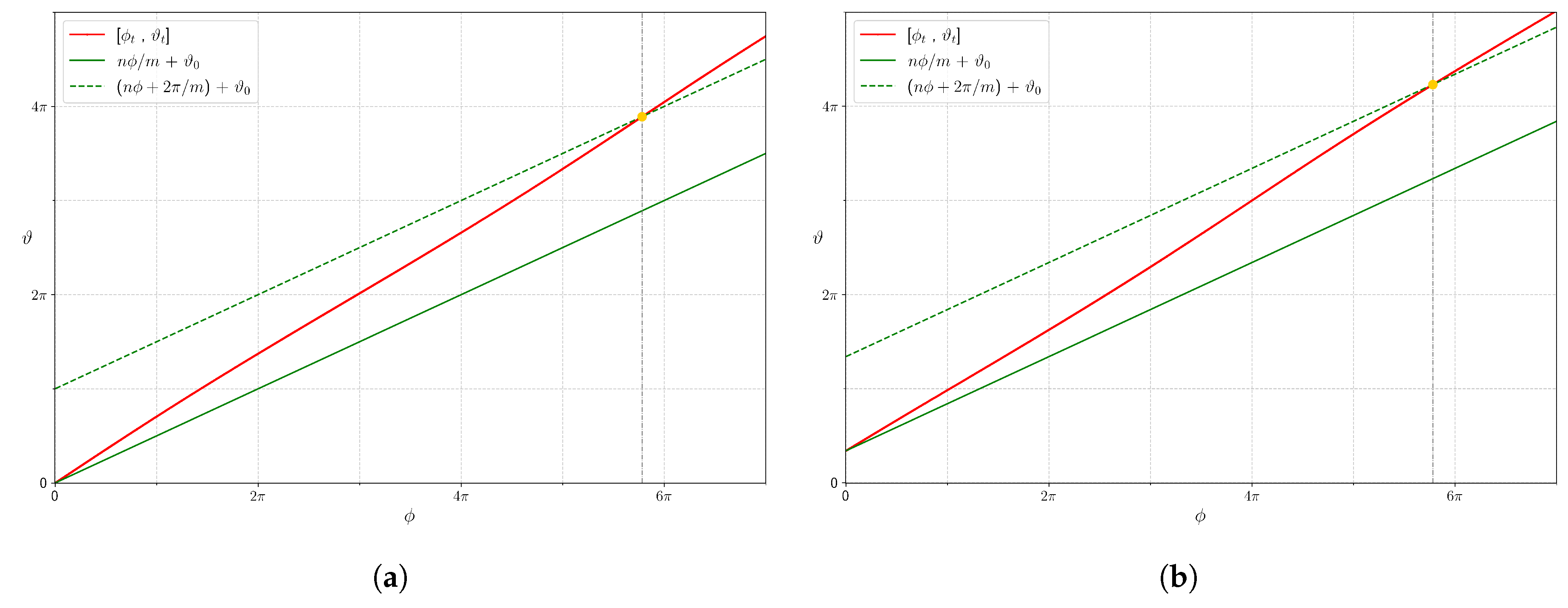2.1. Volume Enclosed by Flux Surfaces
A magnetic field is a vector field B on an orientable three-dimensional manifold M that preserves a volume form Ω (for the standard Euclidean volume, this is the condition ).
We will formulate most of our exposition in the language of exterior calculus because it makes many concepts much simpler to express and some results more evident. It is less familiar to plasma physicists, however, to whom this work is particularly directed, so we translate into vector calculus language in many places.
In the language of exterior calculus, to a magnetic field
B, an associated flux 2-form can be defined as
, allowing the volume-preservation condition to be written as
(i.e.,
is closed: its integral over any closed surface contractible to a point is zero). The vector calculus interpretation of
is that acting on a pair of vectors
and
,
for the area element
given by the oriented parallelogram spanned by
and
. So
can be integrated over a surface
S by chopping
S into little parallelograms, summing their contributions and taking the limit. The exterior derivative
of
is defined to be the 3-form, acting on oriented triples of vectors, that gives the sum of
over the faces of the parallelepiped they span, oriented outwards. The exterior derivative
d on 1-forms is defined similarly, and on functions
,
is just the ordinary derivative. A tutorial on the use of differential forms in plasma physics can be found in [
5].
The fields relevant to the present work, and to much of plasma physics, typically assume the slightly stronger condition that is exact, i.e., for some 1-form . This is equivalent to requiring the existence of a vector potential A such that , where , the 1-form that when acting on any vector produces . Another way to define exactness of is that for any closed surface S, not only contractible ones.
An invariant torus of B is called a flux surface. A magnetic field is called integrable if there is a function (called a flux function or flux surface label) such that almost everywhere (a.e.) and (in vector calculus, a.e. and , but the property does not require the Riemannian metric implicit in ∇ and ·, which is why we prefer to express it using differential forms). For an integrable field, the level sets of are invariant under B. If B and are nowhere-zero on a compact component of a level set, then it is a torus and hence a flux surface. Furthermore, it has a neighbourhood that is foliated by flux surfaces. From KAM theory, if B is non-integrable but smooth enough, then various simple conditions imply a set of positive volumes of flux surfaces, but we will not be using that here.
To quantify the volume V enclosed by a flux surface S, once the surface has been computed, the enclosed volume can be obtained via a 3D integral . This can be reduced to a 2D integral for some 2-form if the manifold M is contractible (i.e., for some 2-form and then the result follows by Stokes’ theorem). For example, if , as for a standard volume in Cartesian coordinates, then one can take , and integrating this over a closed surface corresponds to integrating the height difference between the points of the surface above a given point of the horizontal plane, with respect to horizontal area. However, this direct approach does not take into account the invariance of S under B.
The first formula presented in [
2] for computing the volume that exploits this invariance is:
where
D is a disk transverse to
B whose boundary is on the flux surface
S, and
is the first-return time to
D along the fieldline flow
. Although (
1) is a 2D integral, it involves computing the return-time function, which effectively makes the integration 3D, so there is no real computational reduction (in the
Appendix A, however, a way to reduce the computation of
V from (
1) as a function of
for integrable fields is given).
So we are restricted to a sequence of special cases of magnetic field, for which the integration can be reduced. In the two strongest cases, it is reduced to 2D; in the other two cases, it is reduced to a bit more than 2D, in a sense to be described.
All cases considered are integrable, but they differ in their degree of symmetry. To explain this, note that if B is integrable and non-zero a.e., then there is a vector field u independent of B a.e. such that , where denotes the Lie derivative along u, that is, u is a symmetry of . The expression of this in vector calculus language is . For example, if B is integrable (and divergence-free, always assumed), with flux function , one can take using any Riemannian metric and any function f. But there might be values of u which preserve more than just . For example, u might also preserve (, equivalently ) for some positive function , which we call a density. Or it might preserve volume (so constant density, ); in which case, is also zero (it is equal to the commutator , which can be written as ). If in addition u preserves (, equivalently, ), then we say u is a weak quasisymmetry of B, or it might furthermore preserve (defined the same way as ), at which point we say u is a quasisymmetry of B (in vector calculus, is written as ).
Note that for an integrable field, it makes sense to ask to compute not just the volume enclosed by one flux surface, but instead the whole function giving the volume enclosed as a function of . Our methods will compute this by finding as a 1D integral (or a bit more) and then the function by one more integration.
The proof of (
1), as well as those of Theorems 1–4, can be found in [
2]. A subsection on a new result, Theorem 3’, and its proof, is included.
In contrast to what we have just described, we will now treat the cases in order of decreasing specialisation.
2.1.1. Quasisymmetric Fields
A
quasisymmetric (QS) magnetic field
B is the special case in which there exists a vector field
u independent from
B almost everywhere (in the region of interest), with
Expressions for these in vector calculus language were given above. Under mild additional conditions [
6], every orbit of
u is closed and has the same period
.
The only known analytic examples of these fields (with bounded
u orbits) are axisymmetric, where
in cylindrical coordinates (the vector field with
) (so
). It is an open question whether there are any other exactly quasisymmetric fields, although fields with non-axisymmetric quasisymmetry can be constructed to a high degree of accuracy [
7].
The conditions and imply that is a closed form, i.e., , and, along a path, is unchanged under continuous deformation of the path preserving the ends. Assuming there is no homological obstruction (one might want to assume that every loop is contractible to a point but is stronger than necessary and rules out toroidal geometry; it is enough to suppose that each homology class in dimension 1 can be realised by an orbit of some linear combination of u and B), this further implies that is exact; i.e., there exists a function such that (). It follows that both u and B are tangent to the level sets of , is a flux or a label function, and that the bounded components of the level sets are tori.
Using the volume-preserving property and the conditions in (
2), ref. [
2] provides the following formula. Choose a
u-line
and a point
, then
Theorem 1. , where the return time is the first time for which the flow of B starting at x returns to γ.
The return time can be proved to depend on
x through only
. As computing the return time
requires a 1D integration, the entire volume calculation is thereby reduced to a 2D integral. For clarity, the return time
corresponds to the time between two successive crossings of a fieldline on
S with a
u-line
, while
in (
1) corresponds to the time between two crossings through a given transverse disk
D.
This result generalises to the case of a magnetic field with
weak quasisymmetry [
8]; this is defined by requiring
The only relevant consequence for the volume formula is that now the value of
is in general a function of
. The extended result is the following:
Theorem 2. .
Thus, the computation of the volume is still equivalent to a 2D integration. It is an open question again, however, whether there are any weak QS fields that are not axisymmetric.
2.1.2. Fields with Flux-Form Symmetry
The next case considered in [
2] is magnetic fields
B with
flux-form symmetry, defined as having a volume-preserving vector field
u independent from
B almost everywhere, such that
(recall, this means
because we are assuming
). Perhaps the name is insufficiently clear, because for the definition it is essential that
u be volume-preserving, not just
, but we continue to use it. It is equivalent to require
u to be a volume-preserving field that commutes with
B (e.g., [
6]). It holds for all non-degenerate MHS fields that
, though all examples that we know of such fields are axisymmetric (so are already covered by Theorem 1).
Under the same homological condition, this implies again that
for some function
whose level sets are invariant under both
u and
B. Furthermore, the commutation condition implies that
generates an action
of
on the flux surfaces. For each pair
and point
x on a flux surface,
is given by flowing from
x for time
with
u and time
with
B, in any order because the two fields commute. This is a place where formulation in vector calculus makes it harder to reach the result, though it was achieved by Hamada [
9]. From the condition
, one has to prove that flowing along
u for a time
and along
B for time
commutes. Consequently, for each flux surface, there exists a lattice
of pairs
of times such that
if and only if
. Let
be generators of
. Form a matrix
with the vectors
and
as columns, and let
, which is a function of
. The volume formula for this case can then be written as
Theorem 3. .
2.1.3. Integrable Fields with Symmetry Preserving a Density
In preparing this paper, we realised that several examples, including one that we treat numerically, satisfy
, but with
u preserving a non-constant density
, i.e.,
for some smooth positive function
. Examples of this case that are not covered by a preceding Theorem are given by the fields with helical symmetry from [
10], which is the example we will treat here, and MHD equilibria with flow and electrostatic potential. In the latter example, the electrostatic potential provides an integral; the symmetry field is the plasma velocity, which in general is not volume-preserving but does preserve plasma mass.
Although this case can be treated by Theorem 4 below, we have derived a potentially more efficient formula for it that we explain here.
As before, plus a homological condition implies there is a flux function . The next step is to notice that u commutes with .
Lemma 1. and imply .
Proof. A standard result for commutators of vector fields yields
Recalling that
, the first term gives
using
. Next, use
to obtain
. Then the second term of (
4) gives
, which cancels the first. As
is non-degenerate,
implies that
. □
Together with the linear independence of
u and
B, this implies that on any flux surface
S, the pair
of vector fields induces an action
of
, and the set of pairs
of times for which the resulting
is the identity forms a lattice
. As for Theorem 3, let
be generators for
and
be the determinant of the matrix
they form. Furthermore, the action
allows one to parametrise the flux surface by a pair of angle variables
modulo 1, which evolve at constant speeds with respect to the
u flow and the
flow. They are called
Arnol’d–Liouville (AL) coordinates [
11].
To relate the volume enclosed by
S to its value of
, one more ingredient is required, namely the
harmonic average of
on
S, with respect to the AL coordinates
on it:
This can be computed as the limit of the average of
at the points of a regular subdivision of the lattice
; i.e., for a large enough integer
q, choose a starting point on
S, flow with
for vector-times
with integers
, evaluate
there, and take the average. If everything is analytic, then by Fourier analysis the error is exponentially small in
q (see [
12] for an entertaining exposition of this), so in practice one can expect to get away with a relatively small
q. In this sense, we think of evaluating
as only a bit more than a 1D integral.
We obtain the following theorem for the change in the volume enclosed by a flux surface for a change in the value of
, numbered 3’ because its hypotheses are intermediate between those for Theorems 3 and 4 of [
2].
Theorem 3’. If and , then Proof. Recall that in AL coordinates
, the vector fields
u and
have constant components on each flux surface. Then our key step is to notice that
To prove this, let
n be a vector field such that
(equivalently,
), e.g.,
(for an arbitrary Riemannian metric), and apply
to both sides of (
5). Applied to
this gives
(this is
times the triple product of
), which reduces to
because
and
. Applied to
, it gives
, where
is the matrix formed by the
components of
u and
. Here we have again used that
. Now
is the identity matrix, and so
Because the space of top-forms at a point is one-dimensional, the two sides of (
5) are equal.
Then it follows by integration over S that . □
Apart from the extra factor , using this formula is a simple modification of the case of Theorem 3.
2.1.4. Integrable Fields
After Theorem 3, ref. [
2] presents a weaker version, in which
but
u is not required to be volume-preserving, nor even to preserve a density, so it is weaker than Theorem 3’ too. This case is called
integrable because it is equivalent to the existence of a flux function
whose level sets are invariant (modulo the homological condition). All the previous cases are also integrable but with more conditions on the symmetry field
u. The result is
Theorem 4. Choose a closed curve γ on each flux surface, depending smoothly on Ψ
. Then , where and is defined as the limiting average return time to γ of an infinitely long B-line starting at any point of γ. Note that
is the magnetic flux across a disk spanning
; ref. [
2] gives a way to compute it if the vector potential is not given explicitly. One can compute
, so this is again in the form of evaluating
. We call it a bit more than a 1D integral because evaluating the average return time is longer than a bounded 1D integral.
A question is whether there are integrable magnetic fields for which there is no choice of symmetry field
u that preserves a density. Integrability implies
B is conjugate to
for some function
and constant vector
C for each flux surface [
13], a conclusion that would follow if
has a symmetry field
u that preserves
, so this suggests that the answer is no. Indeed, ref. [
14] shows that in any “toroidal component” for an integrable magnetic field, there is a choice of symmetry field that preserves a density. Their construction uses a result of [
15], which in turn uses a result of Calibi that does not look explicit to us, but they give explicit choices in particular contexts. For example, if
preserves the same function
, then
works, with
. As another example, if
B has a global cross-section, then Birkhoff proved there is an angle variable
that increases by 1 for each return to the section, and [
14] proved that there is a symmetry field
u preserving
(namely the vector field along the contours of
normalised to make
). An interesting challenge is to work out the set of all compatible pairs
for a general integrable
B-field, including at least one explicit case. A curious thing is that the construction of [
14] always produces a symmetry field with a rational winding ratio, whereas there are axisymmetric cases for which this is not the case. Indeed, one can add any flux function times
to
u and get another symmetry preserving the same density, and this will make the winding ratio of
u change continuously, in particular through irrational values.
As a result of this discussion, Theorem 4 may turn out to have little value. Nevertheless, if the construction of a compatible pair is awkward in an example, then it might still be useful. So we also test it.
